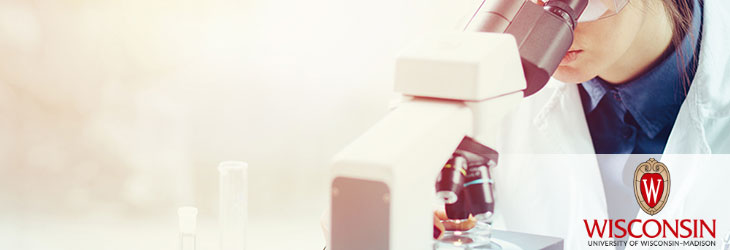Analytical Instrumentation, Methods & Materials

Freezing and Jacketing Gas-Phase Biomolecules with Amorphous Ice for Electron Microscopy
WARF: P200354WO01
Inventors: Joshua Coon, Michael Westphall
The Wisconsin Alumni Research Foundation is seeking commercial partners interested in developing a new cryo-electron microscopy (cryo-EM) sample preparation method. The new technology, called biomolecular vapor deposition (BVD), is a gas-phase sample preparation system that uses mass spectrometry to mitigate many of the shortfalls associated with cryogenically fixing biological samples in amorphous ice.
Overview
Single particle cryo-electron microscopy (cryo-EM) is a powerful tool for providing 3-D structural information on non-crystalline specimens. Cryo-EM approaches atomic level resolution, enabling many new biological discoveries. Unfortunately, this technique still has several limitations, primarily due to sample preparation, which requires purification and vitrification to protect the samples from radiation damage.
At present, sample preparation generally involves solubilization of protein analytes in water, followed by pipetting onto a hydrophilic EM grid. The grid is blotted with filter paper (removing >99.99% of the sample) and then plunged into a bath of cryogen, vitrifying the remaining water/sample. This sample preparation method imparts a preferred orientation of the particles, due largely to particle migration to the air/water interface. This destroys the required structural heterogeneity. In addition, existing preparation methods limit particle density within the grids, resulting in extended data acquisition times and huge data files (5+ Tb).
At present, sample preparation generally involves solubilization of protein analytes in water, followed by pipetting onto a hydrophilic EM grid. The grid is blotted with filter paper (removing >99.99% of the sample) and then plunged into a bath of cryogen, vitrifying the remaining water/sample. This sample preparation method imparts a preferred orientation of the particles, due largely to particle migration to the air/water interface. This destroys the required structural heterogeneity. In addition, existing preparation methods limit particle density within the grids, resulting in extended data acquisition times and huge data files (5+ Tb).
The Invention
UW-Madison researchers have developed a novel cryo-EM sample preparation method called biomolecular vapor deposition (BVD). This is a gas-phase sample preparation system that uses a mass spectrometer to mitigate many of the shortfalls associated with cryogenically fixing biological samples in amorphous ice. This traps gas-phase particles using cryogenic temperatures and “locks in” the particle structure prior to deposition on a cryogenically cooled TEM grid. Once deposited, the trapped particles can be covered with thin films of amorphous ice. Alternatively, the trapped particles can be jacketed with thin films of amorphous ice while being confined in the cryogenic ion trap (that is, prior to deposition). The trapped and jacketed particles can then be deposited onto a cryo-cooled TEM grid within the vacuum for direct cryo-EM imaging.
Applications
- Single particle cryo-electron microscopy. Applications for cryo-EM include structural studies of eukaryotic cells, proteins and macromolecular complexes such as liposomes, organelles and viruses.
Key Benefits
- Increased image resolution
- Decreased image acquisition time
- Increased sensitivity
- Particularly useful for fragile or flexible molecules
Additional Information
For More Information About the Inventors
Tech Fields
For current licensing status, please contact Jennifer Gottwald at [javascript protected email address] or 608-960-9854